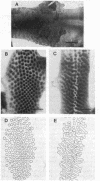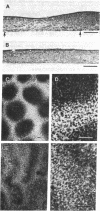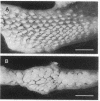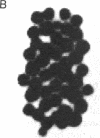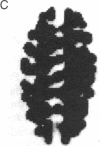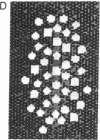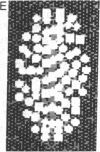Abstract
Cell adhesion molecules (CAMs) may act as regulators of morphogenesis by constraining cell motion, forming borders, and controlling intercellular communications that lead to embryonic induction. This postulated causal role of CAMs in inductive events was tested here in an in vitro system of feather induction. In the developing chicken skin, an ectodermal sheet of epithelium interacts with mesodermal cell collectives to form more or less circular feather germs arranged in a hexagonal pattern. Cells of the epidermal epithelium are linked by liver CAM (L-CAM) and mesodermal cells in dermal condensations are linked by neural CAM (N-CAM); neither of these CAMs links cells in one tissue of this inductive couple to cells in the other. After perturbation of the L-CAM linkage in epidermis by antibodies to L-CAM, nonhexagonal striped patterns of dermal condensations were observed in culture. The stripes did not follow straight lines but meandered in lateral and oblique directions. Histological examination of the perturbed tissues showed extensive changes in dermal cell density distributions. After 10 days of culture, the perturbed tissues developed a cobbled or plaque-like morphology resembling scales rather than the feather-like filamentous structures that formed in unperturbed skin cultures. The results indicate that perturbation of CAM binding in tissues linked by one CAM can alter fates and interactions of cells linked by another, presumably by altering the amount or effect of inductive signals crossing the border between the inducing cell collectives. A computer model based on the notion that the response of L-CAM-linked epidermal cells to signals from N-CAM-linked dermal cells depends cooperatively on the degree of L-CAM linkage was found to generate hexagonal patterns for the unperturbed case and stripes after perturbation of L-CAM bonds.
Full text
PDF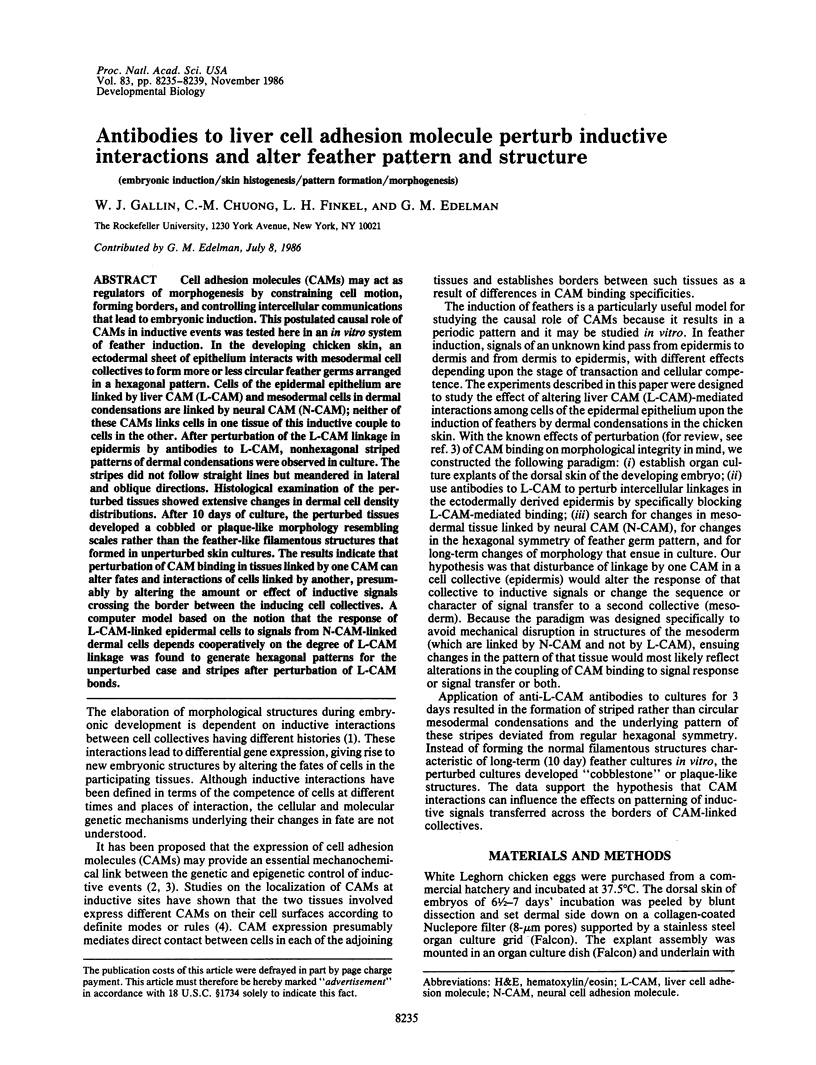
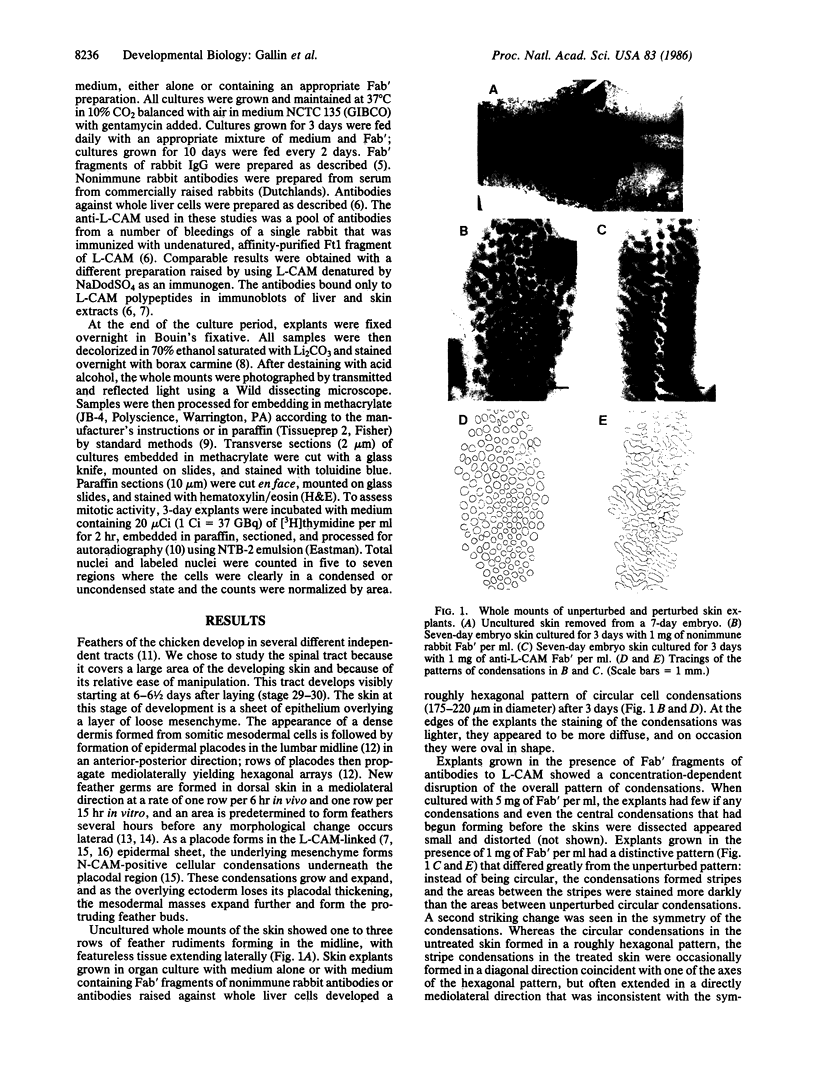
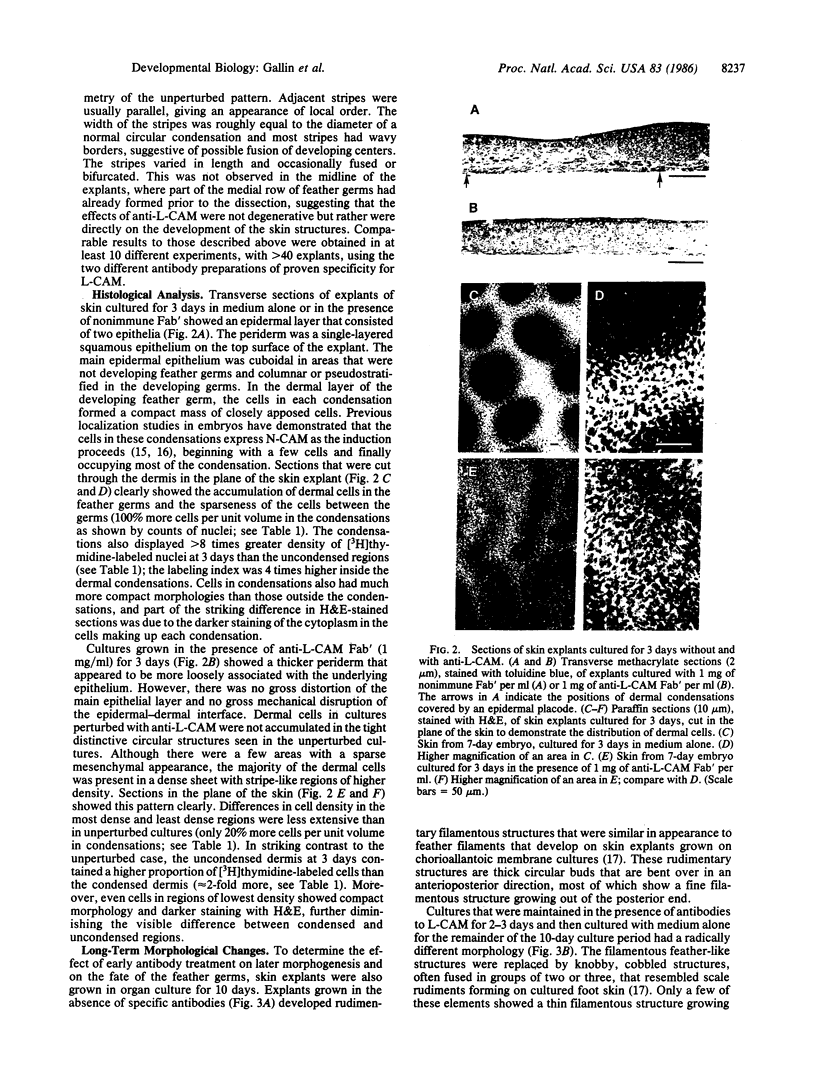
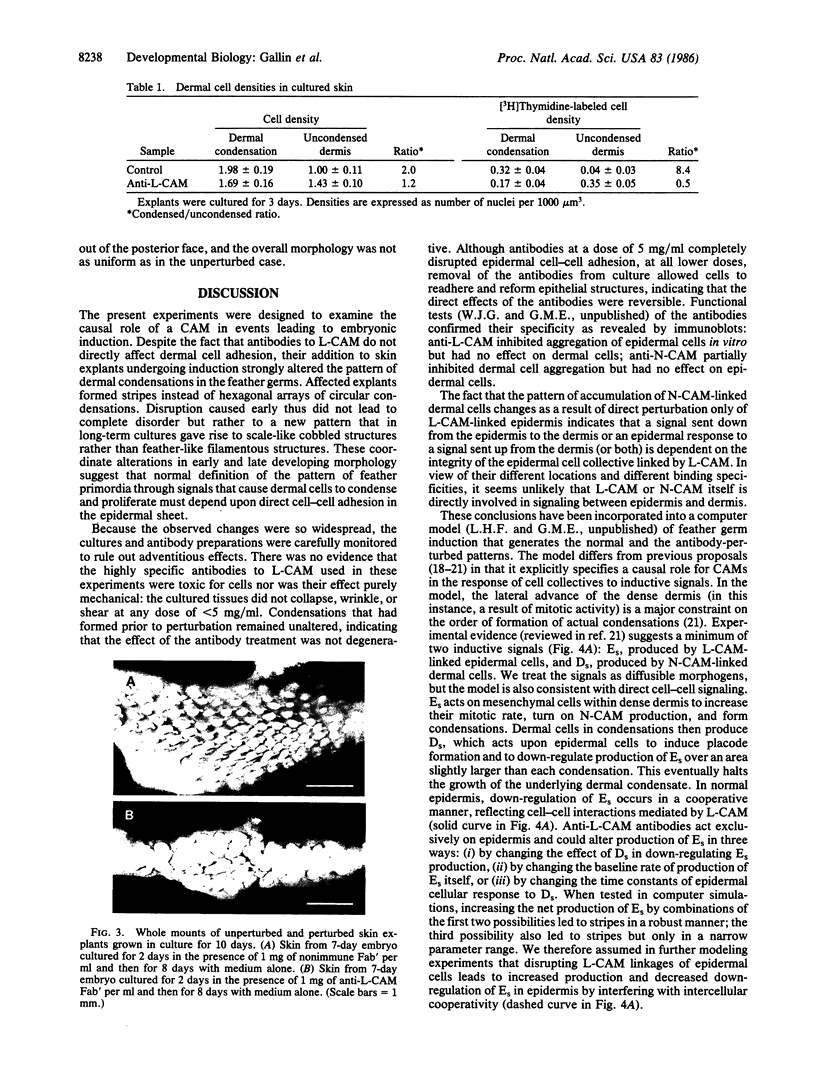

Images in this article
Selected References
These references are in PubMed. This may not be the complete list of references from this article.
- Brackenbury R., Thiery J. P., Rutishauser U., Edelman G. M. Adhesion among neural cells of the chick embryo. I. An immunological assay for molecules involved in cell-cell binding. J Biol Chem. 1977 Oct 10;252(19):6835–6840. [PubMed] [Google Scholar]
- CLAXTON J. H. THE DETERMINATION OF PATTERNS WITH SPECIAL REFERENCE TO THAT OF THE CENTRAL PRIMARY SKIN FOLLICLES IN SHEEP. J Theor Biol. 1964 Sep;7:302–317. doi: 10.1016/0022-5193(64)90074-8. [DOI] [PubMed] [Google Scholar]
- Chuong C. M., Edelman G. M. Expression of cell-adhesion molecules in embryonic induction. I. Morphogenesis of nestling feathers. J Cell Biol. 1985 Sep;101(3):1009–1026. doi: 10.1083/jcb.101.3.1009. [DOI] [PMC free article] [PubMed] [Google Scholar]
- Chuong C. M., Edelman G. M. Expression of cell-adhesion molecules in embryonic induction. II. Morphogenesis of adult feathers. J Cell Biol. 1985 Sep;101(3):1027–1043. doi: 10.1083/jcb.101.3.1027. [DOI] [PMC free article] [PubMed] [Google Scholar]
- Crossin K. L., Chuong C. M., Edelman G. M. Expression sequences of cell adhesion molecules. Proc Natl Acad Sci U S A. 1985 Oct;82(20):6942–6946. doi: 10.1073/pnas.82.20.6942. [DOI] [PMC free article] [PubMed] [Google Scholar]
- Davidson D. The mechanism of feather pattern development in the chick. 1. The time of determination of feather position. J Embryol Exp Morphol. 1983 Apr;74:245–259. [PubMed] [Google Scholar]
- Davidson D. The mechanism of feather pattern development in the chick. II. Control of the sequence of pattern formation. J Embryol Exp Morphol. 1983 Apr;74:261–273. [PubMed] [Google Scholar]
- Ede D. A. Cell behaviour and embryonic development. Int J Neurosci. 1972 Apr;3(4):165–174. doi: 10.3109/00207457209147019. [DOI] [PubMed] [Google Scholar]
- Edelman G. M. Cell adhesion and morphogenesis: the regulator hypothesis. Proc Natl Acad Sci U S A. 1984 Mar;81(5):1460–1464. doi: 10.1073/pnas.81.5.1460. [DOI] [PMC free article] [PubMed] [Google Scholar]
- Edelman G. M. Expression of cell adhesion molecules during embryogenesis and regeneration. Exp Cell Res. 1985 Nov;161(1):1–16. doi: 10.1016/0014-4827(85)90485-9. [DOI] [PubMed] [Google Scholar]
- Gallin W. J., Edelman G. M., Cunningham B. A. Characterization of L-CAM, a major cell adhesion molecule from embryonic liver cells. Proc Natl Acad Sci U S A. 1983 Feb;80(4):1038–1042. doi: 10.1073/pnas.80.4.1038. [DOI] [PMC free article] [PubMed] [Google Scholar]
- Mayerson P. L., Fallon J. F. The spatial pattern and temporal sequence in which feather germs arise in the white Leghorn chick embryo. Dev Biol. 1985 Jun;109(2):259–267. doi: 10.1016/0012-1606(85)90453-1. [DOI] [PubMed] [Google Scholar]
- Oster G. F., Murray J. D., Harris A. K. Mechanical aspects of mesenchymal morphogenesis. J Embryol Exp Morphol. 1983 Dec;78:83–125. [PubMed] [Google Scholar]
- SENGEL P., ABBOTT U. K. IN VITRO STUDIES WITH THE SCALELESS MUTANT. INTERACTIONS DURING FEATHER AND SCALE DIFFERENTIATION. J Hered. 1963 Nov-Dec;54:255–262. doi: 10.1093/oxfordjournals.jhered.a107261. [DOI] [PubMed] [Google Scholar]
- Thiery J. P., Delouvée A., Gallin W. J., Cunningham B. A., Edelman G. M. Ontogenetic expression of cell adhesion molecules: L-CAM is found in epithelia derived from the three primary germ layers. Dev Biol. 1984 Mar;102(1):61–78. doi: 10.1016/0012-1606(84)90175-1. [DOI] [PubMed] [Google Scholar]
- Wessells N. K. Morphology and proliferation during early feather development. Dev Biol. 1965 Aug;12(1):131–153. doi: 10.1016/0012-1606(65)90025-4. [DOI] [PubMed] [Google Scholar]



